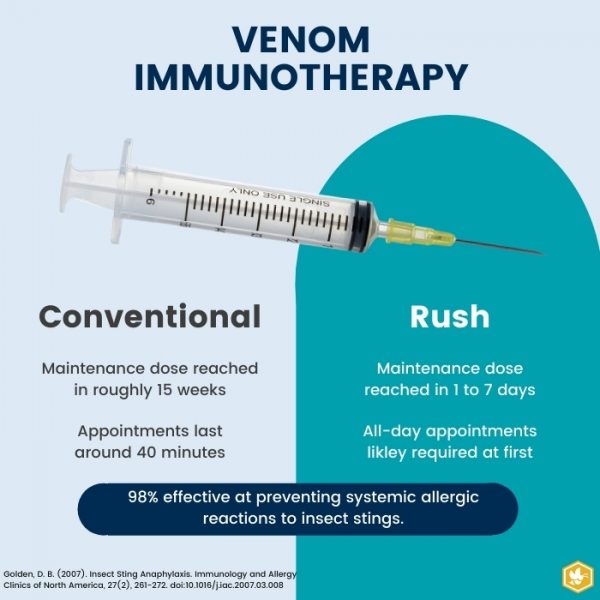Rush venom immunotherapy is a treatment that can quickly reduce the risk of systemic bee sting allergic reactions. There are many reasons rush may be chosen over standard practices, but ultimately, it is a decision an allergist and their patient must decide together. Prepare for a conversation with your doctor by becoming informed of treatment options now.
a baseline: CONVENTIONAL venom immunotherapy
The best way to explain rush immunotherapy is to describe conventional treatment first. Venom immunotherapy is a series of allergy shots. At a doctor’s office, a patient receives doses of wasp and/or bee venom through injection. The treatment is specifically designed for the patient by adjusting the dose and intervals between injections.
Dosing
Allergists use a dosing schedule. First, during the “build-up phase” doctors provide patients with slowly increasing amounts of diluted venom extract. When the ideal concentration is reached, the build-up phase is complete and the maintenance phase begins. Once the patient is regularly receiving the maintenance dose, then their risk of a bee sting allergic reaction drops to about 3%.10
More accurately, the beginning doses of venom are no greater than 0.1 to 1.0 mcg. Then, the maintenance dose is typically 100 mcg. All of these specifics can be adjusted based on the patient’s tolerance.
Bee sting allergies are serious
Intervals Between Injections
Usually, patients receive one shot per week, with each shot’s concentration increasing over an average of 15 weeks.6 By then, they will have reached the maintenance phase and shots can be administered less frequently. It’s common to increase the interval to 4-weeks between shots during the first year of treatment. Then, the patient may receive shots every 6 to 8 weeks.14
However, just like dosing, intervals may need adjusting per patient and their unique situation. Some choose to receive two shots per week. Some choose the “cluster” method: a few shots in a single appointment, several days apart. Lastly, some may opt for rush or ultrarush immunotherapy.

CONVENTIONAL vs Rush Immunotherapy
Rush immunotherapy provides higher doses of venom in a shorter time period. Instead of reaching the maintenance dose over the course of weeks, an allergist may opt for days, or even hours (ultrarush). Faster treatment options mean a day or more primarily spent in the clinic.
Rush patients will still need to continue receiving shots after reaching the maitenance dose. However, they can trust that they are adequately protected from wasp and bee stings after this time-condensed treatment.
Why Rush Instead of Conventional
There are a couple reasons someone may choose rush immunotherapy over the traditional method.
First, conventional treatment requires time to achieve maintenance dosing. Many people don’t have the ability to commit to receiving shots once per week for several months. That’s a lot of time driving and away from work. It isn’t ideal for a patient to quit or refuse treatment if they truly need it, so an allergist may use rush to work around this barrier if it is safe to do so.
Second, for those with very severe allergies and a higher risk of being stung, rush treatment may be the safest option. For example, children spend more time outdoors and are less aware of their surroundings. Allergists are more likely to consider a child for rush venom immunotherapy so that they can be safe outside again. While adults are better able to avoid bees and wasps, a high-risk occupation may make them a rush candidate. Beekeepers, contractors, and farmers are primary examples.
Side Effects & Safety: Rush vs Conventional
Is there a difference in the safety or side effects of rush and conventional treament? We’ve found a study that can help answer this question.
Over eight years, a team of allergists performed rush venom immunotherapy on 101 patients. All but one of the patients reached the maintenance dose (99%) over a four-day period. During treatment, eight systemic reactions occured (0.47% of all injections given) in 7 (6.9%) patients. None of the reactions required epinephrine.
This study also documented outside research done on rush and standard immunotherapy. After taking into consideration other results and different ways of documenting symptoms, here is what they found:
- 17.8% of venom immunotherapy patients experience a systemic reaction of varying degrees during treatment.
- Standard or cluster treatment plans produce systemic reactions 11.2% of the time.
- Rush treatment produces systemic reactions 25.6% of the time.
- Ultrarush treatment produces systemic reactions 11.3% of the time.
Determining if Rush Immunotherapy is right for you
An allergist’s priority is to keep you safe. If you have hesitations or concerns, work with them to get the answers you need. In the end, the risk of systemic allergic reaction to bee stings can be lowered: in days, weeks, or months. Through testing and discssion, your allergist can come up with the best treatment plan for you.
Need help finding an allergist? Seach now.


Find a Local Allergist
If you think you have a bee sting allergy, don’t wait for an emergency. Instead, talk to an allergist about testing and venom immunotherapy.






